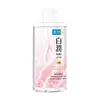What's inside
What's inside
 Key Ingredients
Key Ingredients

 Benefits
Benefits

 Concerns
Concerns

 Ingredients Side-by-side
Ingredients Side-by-side

Water
Skin ConditioningGlycerin
HumectantIsopropyl Palmitate
EmollientPentylene Glycol
Skin ConditioningAlcohol Denat.
AntimicrobialPEG-100 Stearate
Glyceryl Stearate
EmollientCetyl Alcohol
EmollientCarbomer
Emulsion StabilisingTriethanolamine
BufferingAcetyl Trifluoromethylphenyl Valylglycine
Skin ConditioningAscorbyl Glucoside
AntioxidantCapryloyl Salicylic Acid
ExfoliatingXanthan Gum
EmulsifyingDisodium Cocoamphodiacetate
CleansingDisodium EDTA
Methylparaben
PreservativeQuaternium-15
PreservativeParfum
MaskingLinalool
PerfumingBenzyl Salicylate
PerfumingCitronellol
PerfumingAlpha-Isomethyl Ionone
PerfumingGeraniol
PerfumingLimonene
PerfumingCoumarin
PerfumingHydroxyisohexyl 3-Cyclohexene Carboxaldehyde
MaskingButylphenyl Methylpropional
PerfumingWater, Glycerin, Isopropyl Palmitate, Pentylene Glycol, Alcohol Denat., PEG-100 Stearate, Glyceryl Stearate, Cetyl Alcohol, Carbomer, Triethanolamine, Acetyl Trifluoromethylphenyl Valylglycine, Ascorbyl Glucoside, Capryloyl Salicylic Acid, Xanthan Gum, Disodium Cocoamphodiacetate, Disodium EDTA, Methylparaben, Quaternium-15, Parfum, Linalool, Benzyl Salicylate, Citronellol, Alpha-Isomethyl Ionone, Geraniol, Limonene, Coumarin, Hydroxyisohexyl 3-Cyclohexene Carboxaldehyde, Butylphenyl Methylpropional
Water
Skin ConditioningGlycerin
HumectantPEG-7 Caprylic/Capric Glycerides
EmulsifyingPropanediol
SolventPEG-6 Caprylic/Capric Glycerides
EmulsifyingSodium Cocoamphoacetate
CleansingChlorphenesin
AntimicrobialPEG/PPG/Polybutylene Glycol-8/5/3 Glycerin
HumectantXylitylglucoside
HumectantPolyaminopropyl Biguanide
PreservativeSodium Chloride
MaskingAnhydroxylitol
HumectantDisodium EDTA
Xylitol
HumectantSodium Hyaluronate
HumectantPhytic Acid
3-O-Ethyl Ascorbic Acid
Skin ConditioningSalicylic Acid
MaskingPotassium Azeloyl Diglycinate
Skin ConditioningAmylopectin
Dextrin
AbsorbentXanthan Gum
EmulsifyingButylene Glycol
Humectant1,2-Hexanediol
Skin ConditioningPhenoxyethanol
PreservativePentylene Glycol
Skin ConditioningPolyquaternium-10
Hydrolyzed Sodium Hyaluronate
Skin ConditioningMoringa Oleifera Seed Extract
Skin ConditioningBiosaccharide Gum-4
Skin ConditioningDisodium Phosphate
BufferingPotassium Chloride
Citric Acid
BufferingCaprylyl Glycol
EmollientWater, Glycerin, PEG-7 Caprylic/Capric Glycerides, Propanediol, PEG-6 Caprylic/Capric Glycerides, Sodium Cocoamphoacetate, Chlorphenesin, PEG/PPG/Polybutylene Glycol-8/5/3 Glycerin, Xylitylglucoside, Polyaminopropyl Biguanide, Sodium Chloride, Anhydroxylitol, Disodium EDTA, Xylitol, Sodium Hyaluronate, Phytic Acid, 3-O-Ethyl Ascorbic Acid, Salicylic Acid, Potassium Azeloyl Diglycinate, Amylopectin, Dextrin, Xanthan Gum, Butylene Glycol, 1,2-Hexanediol, Phenoxyethanol, Pentylene Glycol, Polyquaternium-10, Hydrolyzed Sodium Hyaluronate, Moringa Oleifera Seed Extract, Biosaccharide Gum-4, Disodium Phosphate, Potassium Chloride, Citric Acid, Caprylyl Glycol
Ingredients Explained
These ingredients are found in both products.
Ingredients higher up in an ingredient list are typically present in a larger amount.
Disodium EDTA plays a role in making products more stable by aiding other preservatives.
It is a chelating agent, meaning it neutralizes metal ions that may be found in a product.
Disodium EDTA is a salt of edetic acid and is found to be safe in cosmetic ingredients.
Learn more about Disodium EDTAGlycerin is already naturally found in your skin. It helps moisturize and protect your skin.
A study from 2016 found glycerin to be more effective as a humectant than AHAs and hyaluronic acid.
As a humectant, it helps the skin stay hydrated by pulling moisture to your skin. The low molecular weight of glycerin allows it to pull moisture into the deeper layers of your skin.
Hydrated skin improves your skin barrier; Your skin barrier helps protect against irritants and bacteria.
Glycerin has also been found to have antimicrobial and antiviral properties. Due to these properties, glycerin is often used in wound and burn treatments.
In cosmetics, glycerin is usually derived from plants such as soybean or palm. However, it can also be sourced from animals, such as tallow or animal fat.
This ingredient is organic, colorless, odorless, and non-toxic.
Glycerin is the name for this ingredient in American English. British English uses Glycerol/Glycerine.
Learn more about GlycerinPentylene glycol is typically used within a product to thicken it. It also adds a smooth, soft, and moisturizing feel to the product. It is naturally found in plants such as sugar beets.
The hydrophilic trait of Pentylene Glycol makes it a humectant. As a humectant, Pentylene Glycol helps draw moisture from the air to your skin. This can help keep your skin hydrated.
This property also makes Pentylene Glycol a great texture enhancer. It can also help thicken or stabilize a product.
Pentylene Glycol also acts as a mild preservative and helps to keep a product microbe-free.
Some people may experience mild eye and skin irritation from Pentylene Glycol. We always recommend speaking with a professional about using this ingredient in your routine.
Pentylene Glycol has a low molecular weight and is part of the 1,2-glycol family.
Learn more about Pentylene GlycolWater. It's the most common cosmetic ingredient of all. You'll usually see it at the top of ingredient lists, meaning that it makes up the largest part of the product.
So why is it so popular? Water most often acts as a solvent - this means that it helps dissolve other ingredients into the formulation.
You'll also recognize water as that liquid we all need to stay alive. If you see this, drink a glass of water. Stay hydrated!
Learn more about WaterXanthan gum is used as a stabilizer and thickener within cosmetic products. It helps give products a sticky, thick feeling - preventing them from being too runny.
On the technical side of things, xanthan gum is a polysaccharide - a combination consisting of multiple sugar molecules bonded together.
Xanthan gum is a pretty common and great ingredient. It is a natural, non-toxic, non-irritating ingredient that is also commonly used in food products.
Learn more about Xanthan Gum